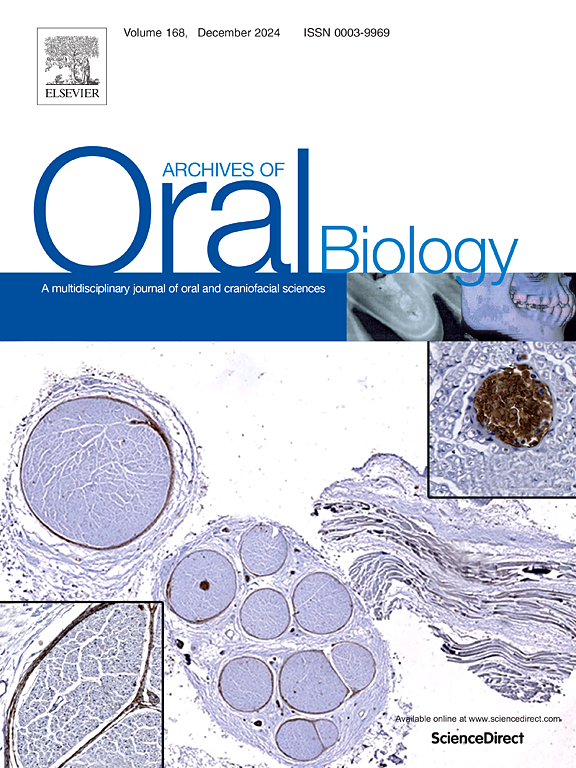老年人和成年人口腔微生物群的差异:一项系统综述
IF 2.2
4区 医学
Q2 DENTISTRY, ORAL SURGERY & MEDICINE
引用次数: 0
摘要
衰老过程可能显著影响口腔细菌(口腔微生物组),导致其多样性和组成发生显著变化,可能影响全身健康。本系统综述旨在比较老年人(≥60岁)和年轻人的口腔微生物群。DesignA对PubMed、Medline、EMBASE和CINAHL的综合检索确定了2005年至2023年5月间发表的794项研究。如果研究人员使用16S rRNA测序比较老年人和年轻人的口腔微生物组,则纳入研究。采用JBI分析性横断面研究关键评价清单评估偏倚风险。10篇全文文章符合纳入标准。结果纳入的研究显示,随着年龄的增长,α和β多样性以及细菌门的丰度的结果不一致。一些研究报告多样性或丰度增加,另一些则显示减少,还有一些没有发现显著差异。然而,本综述在多个研究中发现,在老年人群中,嗜血杆菌、肉芽胞菌和细孔菌的丰度持续下降,而单胞菌的丰度则增加。这些属可能在维持老年人口腔健康和微生物稳定性方面发挥关键作用,强调需要进一步研究。结论微生物多样性和丰度的差异表明,口腔卫生、全身健康、药物使用和生活方式等混杂因素可能使结果的解释复杂化。总之,未来的研究应采用标准化方法的纵向设计,并解决混杂因素,以更好地了解口腔微生物群老化及其对健康寿命和生活质量的影响。本文章由计算机程序翻译,如有差异,请以英文原文为准。
Differences in oral microbiota between elderly and adults: A systematic review
Objective
The aging process may significantly impact bacteria in the oral cavity (oral microbiome), leading to notable changes in its diversity and composition, potentially influencing systemic health. This systematic review aimed to compare the oral microbiota of elderly individuals (≥60 years) with that of younger adults.
Design
A comprehensive search of PubMed, Medline, EMBASE and CINAHL identified 794 studies published between 2005 and May 2023. Studies were included if the investigators compared the oral microbiome of elderly with younger adults using 16S rRNA sequencing. The JBI Critical Appraisal Checklist for Analytical Cross-Sectional Studies was employed to evaluate risk of bias. Ten full-text articles met the criteria for inclusion.
Results
The included studies revealed inconsistent results regarding alpha and beta diversity and the abundance of bacterial phyla with aging. Some studies reported increased diversity or abundance, others showed decreases, and several found no significant differences. However, this review identified a consistent decline in the abundance of Haemophilus, Granulicatella, and Veillonella, alongside an increase in Comamonas, in elderly populations across multiple studies. These genera may play critical roles in maintaining oral health and microbial stability in elderly populations, highlighting the need for further investigation.
Conclusions
The variability in microbial diversity and abudance suggests that confounding factors such as oral hygiene, systemic health, medication use, and lifestyle may complicate interpretation of results. In conclusion, future research should employ longitudinal designs with standardized methodologies and address confounding factors to better understand the aging oral microbiome and its implications for healthspan and quality of life.
求助全文
通过发布文献求助,成功后即可免费获取论文全文。
去求助
来源期刊

Archives of oral biology
医学-牙科与口腔外科
CiteScore
5.10
自引率
3.30%
发文量
177
审稿时长
26 days
期刊介绍:
Archives of Oral Biology is an international journal which aims to publish papers of the highest scientific quality in the oral and craniofacial sciences. The journal is particularly interested in research which advances knowledge in the mechanisms of craniofacial development and disease, including:
Cell and molecular biology
Molecular genetics
Immunology
Pathogenesis
Cellular microbiology
Embryology
Syndromology
Forensic dentistry
 求助内容:
求助内容: 应助结果提醒方式:
应助结果提醒方式:


